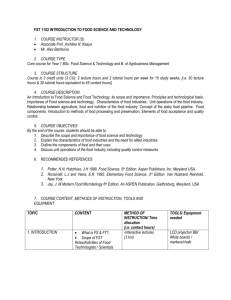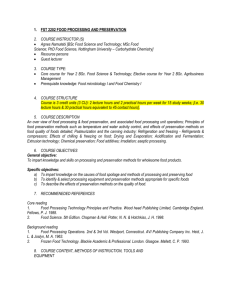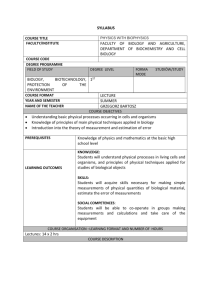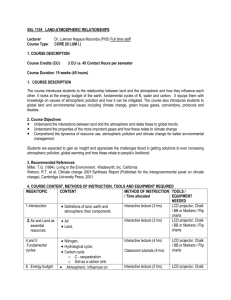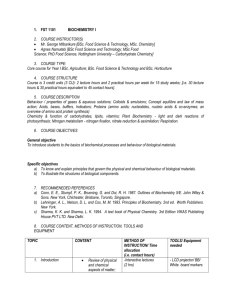AHN7207 FOOD PROCESSING AND PRESERVATION
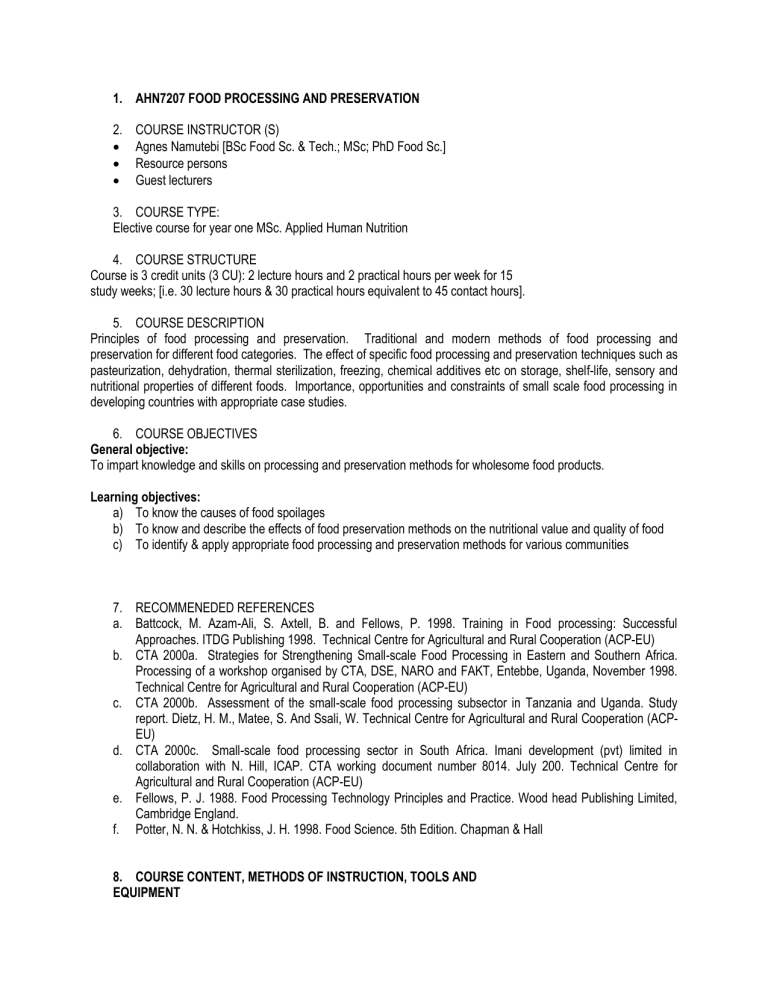
1.
AHN7207 FOOD PROCESSING AND PRESERVATION
2.
COURSE INSTRUCTOR (S)
Agnes Namutebi [BSc Food Sc. & Tech.; MSc; PhD Food Sc.]
Resource persons
Guest lecturers
3.
COURSE TYPE:
Elective course for year one MSc. Applied Human Nutrition
4.
COURSE STRUCTURE
Course is 3 credit units (3 CU): 2 lecture hours and 2 practical hours per week for 15 study weeks; [i.e. 30 lecture hours & 30 practical hours equivalent to 45 contact hours].
5.
COURSE DESCRIPTION
Principles of food processing and preservation. Traditional and modern methods of food processing and preservation for different food categories. The effect of specific food processing and preservation techniques such as pasteurization, dehydration, thermal sterilization, freezing, chemical additives etc on storage, shelf-life, sensory and nutritional properties of different foods. Importance, opportunities and constraints of small scale food processing in developing countries with appropriate case studies.
6.
COURSE OBJECTIVES
General objective:
To impart knowledge and skills on processing and preservation methods for wholesome food products.
Learning objectives: a) To know the causes of food spoilages b) To know and describe the effects of food preservation methods on the nutritional value and quality of food c) To identify & apply appropriate food processing and preservation methods for various communities
7.
RECOMMENEDED REFERENCES a.
Battcock, M. Azam-Ali, S. Axtell, B. and Fellows, P. 1998. Training in Food processing: Successful
Approaches. ITDG Publishing 1998. Technical Centre for Agricultural and Rural Cooperation (ACP-EU) b.
CTA 2000a. Strategies for Strengthening Small-scale Food Processing in Eastern and Southern Africa.
Processing of a workshop organised by CTA, DSE, NARO and FAKT, Entebbe, Uganda, November 1998.
Technical Centre for Agricultural and Rural Cooperation (ACP-EU) c.
CTA 2000b. Assessment of the small-scale food processing subsector in Tanzania and Uganda. Study report. Dietz, H. M., Matee, S. And Ssali, W. Technical Centre for Agricultural and Rural Cooperation (ACP-
EU) d.
CTA 2000c. Small-scale food processing sector in South Africa. Imani development (pvt) limited in collaboration with N. Hill, ICAP. CTA working document number 8014. July 200. Technical Centre for
Agricultural and Rural Cooperation (ACP-EU) e.
Fellows, P. J. 1988. Food Processing Technology Principles and Practice. Wood head Publishing Limited,
Cambridge England. f.
Potter, N. N. & Hotchkiss, J. H. 1998. Food Science. 5th Edition. Chapman & Hall
8.
COURSE CONTENT, METHODS OF INSTRUCTION, TOOLS AND
EQUIPMENT
TOPIC No. CONTENT (sub topics)
1.
An overview to food processing
2.
The role of preserving food to deter spoilage
Food preservation technologies used in the food industry
Traditional versus modern methods of food preservation
Evaluate the state of industries in specific developing countries
Causes of food spoilage
Types of food spoilage
3.
4.
5.
6.
Food preservation methods & their effects on foods
Food preservation methods
Food preservation methods
Food preservation methods
METHOD OF
INSTRUCTION/ Time allocation
Interactive lectures
(2 hrs)
Pilot plant operations
(3 hrs)
TOOLS/ Equipment needed
Visual aids [LCD projector/ white board & BB markers]
Handouts
Role of water in food spoilage
Principles of food preservation methods
Pasteurisation and
Canning
Assignments: calculations on heat processing parameters; significance heat labile nutrients and heat resistant microorganims
Practical: Thermal food processes in the processing pilot plants
Catalase enzyme test for blanching
Cold storage methods: chilling & freezing)
Study visit: Types of chillers & freezers
Drying
Study visit: Designs and
Interactive lectures
(2 hrs)
Interactive lectures
(3 hrs)
Interactive lectures
(6 hrs)
Pilot processing
plant practical (3 hrs)
Lab practical (3 hrs)
Lectures (3 hrs)
Fish industry visit (3 hrs)
Student assignment
& presentation (2 hrs)
Amfri Farm visit (3 hrs)
Visual aids [LCD projector/ white board & BB markers]
Handouts
Visual aids [LCD projector/ white board & BB markers]
Handout notes
Visual aids [LCD projector/ white board & BB markers]
Handout notes
Food materials & consumables
Food materials & reagents
Visual aids [LCD
projector/ white board & BB markers]
Transport
Visual aids [LCD projector/ white board & BB markers]; Handouts
Transport
7.
8.
9.
10.
11.
Food preservation methods
12.
Overview of other food processing methods
13.
Overview of other food processing methods
14.
Food preservation methods
Food preservation methods
Food preservation methods
Small-scale food processors in developing economies
Curing, Food additives & chemical preservatives
Smoking as a food preservation method
Evaporation
Open-pan evaporation method
Mid-semester test
Natural anti-microbials from microorganisms, plants & animals
Types of Solar dryers
Lab practical: Effect of drying methods on nutrients
Fermentation
Concept of hurdle technologies
Modified atmosphere packaging
Aseptic technology
Microwave technology
Case study assessments of small scale food processing;
Implications on safety of food; Cost of production; size & capacity of processing
Strategies for improvement of small food processing
Lab plant practical (3 hrs)
Student assignment
& presentation (2 hrs)
Student assignments
& presentations (2 hrs)
Pilot processing plant practical (3 hrs)
Interactive lectures
(3 hrs)
Pilot processing plant practical (3 hrs)
2 hr
Interactive lectures
(2 hrs)
Chemical reagents; Food materials
Visual aids [LCD projector/ white board & BB markers];
Handouts
Visual aids [LCD projector/ white board & BB markers];
Handout notes
Visual aids [LCD projector/ white board & BB markers]
Consumables
Interactive lectures
(1 h)
Interactive lectures
(2 hrs)
Student assignment
& presentation (6 hrs)
Stationary
Visual aids [LCD projector/ white board & BB markers]
Hand out notes
Visual aids [LCD projector/ white board & BB markers]
Hand out notes
Visual aids [LCD projector/ white board & BB markers]
Hand out notes
Visual aids [LCD projector/ white board & BB markers]
Hand out notes
Text books and related journals
(both hard & electronic)
9.
SUMMARY OF TIME NEEDED
Lecture hours
Laboratory hours
Pilot processing plant hours
Field/ industry learning visits
Case study presentations
10.
OVERALL COURSE EVALUATION
Final exam
Continuous assessment
Practical reports (10%)
One mid semester test (10%)
Individual written assignments (10%)
Group reports & presentations (10%)
END
30 hrs
12 hrs
6 hrs
6 hrs
6 hrs
60%
40%
